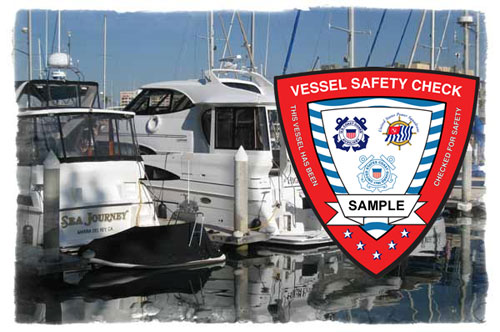Return to Division 20's Home Page.
Request Your Vessel Safety Check Today!

At your request, one of our Flotillas' certified vessel examiners will perform a free, voluntary, no-consequence review of the safety equipment on your boat. If your boat passes the exam, you will receive a decal for your boat, similar to the one on the right, showing your commitment to safe boating to the public and to law enforcement.
Use the link above to get in communicate with us and schedule your vessel safety check. We are happy to examine your boat at the location of your choosing to include your home or any local marina.
Benefits of a FREE vessel safety check:
- Peace of mind - you'll feel much safer on the water with friends and family knowing you have all the right gear on board and in good condition.
- Be prepared for anything - the list of safety gear identified on the Coast Guard's recreational boating safety checklist is often above and beyond what is required by most state boating laws to make sure that you have everything you could possibly need for most any contingency.
- Stay on good terms with law enforcement - having an official vessel safety check decal on your boat shows the public and law enforcement your commitment to safe boating. Get a Vessel Safety check today!
We're just here to help you be safe on the water!
Our vessel safety checks are 100% free and voluntary, and confidential with no penalties for "failures." We're here to help you be safe on the water - that's all! If a piece of safety gear is missing we'll advise you on where to find it so you can boat with confidence. Preventing maritime loss of life and property is one of the primary missions of the Coast Guard Auxiliary.
Please take advantage of this free service and are more than happy to answer any questions you may have.
What's involved in a vessel safety check?
Here are a few of the items that will be on our checklist when we perform a vessel safety check on your boat. For a complete list, please see the Auxiliary's virtual vessel exam page.
1. Registration Number
The boat's registration number must be attached permanently to each side of the forward half of the boat They must be plain, vertical, block characters, not less than three (3) inches high, and in a color contrasting with the background. A space or hyphen must separate the letters from the numbers. Place your NC state tax sticker according to NC Department of Game and Inland Fisheries policy, which is illustrated here. (e.g. NC 1234 AB or NC-1234-AB)
2. Registration/Documentation
Registration or documentation papers must be on board and available. Documentation numbers must be permanently marked on a visible part of the interior structure. Your documented boat's name and hailing port must be displayed on the exterior hull in letters not less than four (4) inches in height. To be documented, a boat must be 5 net tons or greater.
3. Personal Flotation Devices (PFDs)
You should have one wearable personal flotation device (more commonly known as a life jacket) for every person on your boat, plus at least one throwable PFD. All PFDs must be U.S. Coast Guard approved, in good serviceable condition, and of suitable size for the each person on the boat. Children must have properly fitted PFDs designed for children. Wearable PFDs and throwable PFDs must be "immediately available." PFDs should NOT be stored in unopened plastic packaging. For Personal Watercraft (jetski) riders, the PFD must be worn and indicate an impact rating. Boats 16 Feet or longer, must also have one Type IV PFD.
4. Visual Distress Signals (VSDs)
- Three (3) day and three night pyrotechnic devices
- One (1) day non-pyrotechnic device (flag) and one night non-pyrotechnic device (auto SOS light) or combination of 1 and 2
- Recreational boats less than 16 feet on coastal waters or the Great Lakes need only carry night visual distress signals when operating from sunset to sunrise.
5. Fire Extinguishers
Fire extinguishers are required if one of the following conditions exists:
- Inboard engine(s)
- Closed compartments that store portable fuel tanks
- Double bottom hulls not completely sealed or not completely filled with flotation materials
- Closed living space
- Closed stowage compartments that contain flammable materials
- Permanently installed fuel tanks
Fire extinguishers must be readily accessible and verified as serviceable.